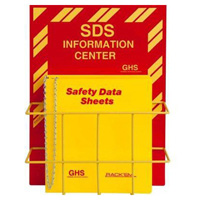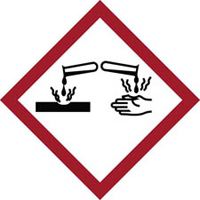| The Home page of ILPI's Safety Data Sheet (SDS) Resource, the leader in SDS information since 1995! | |
| The history and philosophy behind this resource. | |
| A curated collection of books and reference materials concerning Safety Data Sheets and closely related topics. | |
| Paste your plain text SDS into the SDS-Demystifier, and it will be converted into a hypertext-enriched document with links to detailed explanations of each key term. | |
| An extensive list of frequently asked questions about Safety Data Sheets including regulations, content, compliance, and more. | |
| A humorous take on Safety Data Sheet jargon. Fill in the blanks on our entry form to generate a personalized Unsafety Data Sheet to share with your coworkers. | |
| Since 1995, we've maintained this massive curated list of the best places to find Safety Data Sheets on the Internet. | |
| Way more than a glossary, this hypertext-enhanced resource covers hundreds of SDS-related terms and expert knowledge. Each entry includes both the SDS relevance and links to additional authoritative resources. | |
| Archived results of Safety Data Sheet related polls taken by some of our millions of site visitors | |
| You are here! The OSHA regulations behind SDS regulations, including the inspection guidelines and over 400 official interpretations letters under the Hazard Communication Standard | |
| Commercial suppliers of SDS authoring and management software as well as cloud compliance services. | |
| Commercial companies that will create SDS's for your specific needs as well as SDS translation companies. |

Safety signs, banners, and scoreboards? Get yours at Safety Emporium!
| Title: 07/13/2012 - Hazard communication of ammonia gas from new fuel additive in diesel trucks | |
| Record Type: Interpretation | Standard Number: 1910.1200 |
ILPI Notes: Sections of this interpretation are based on and reference the HCS 1994 which is now obsolete. It references portions of the standard that have since been deleted or changed. The answer given for Question 2 below is now obsolete/invalid under current regulations, but if one follows the current HCS 2012 rules for labeling the basic thrust of this interpretation may still be valid.
July 13, 2012
Mr. Bruce D. Groves, CIH
Emilcott Associates, Inc.
[Now Triumvirate Environmental]
190 Park Avenue
Morristown, NJ 07960
Dear Mr. Groves:
Thank you for your January 30, 2011, letter to the Occupational Safety and Health Administration's (OSHA's) Directorate of Enforcement Programs. Your questions regarded the health and safety issues involved when motor carriers use selective catalytic reduction with urea (SCR-urea) to meet new emission standards of the U.S. Environmental Protection Agency. Some designs to implement the new SCR-urea systems involve a small tank on the truck to hold the urea-based additive, also known as diesel exhaust fluid (DEF), which require periodic re-filling, much like fuel tanks are refilled on trucks. You indicated that ammonia gas can accumulate in the headspace of DEF tanks. Your paraphrased questions are below followed by our responses.
Question 1: Should a hazard warning label for ammonia be required on the vehicle by the DEF tank cap where the worker may be exposed?
Response: OSHA's Hazard Communication standard (HCS), 29 CFR 1910.1200 [in context: HCS 1994 | current regulation: HCS 2012] , outlines the requirements for labeling of chemical containers. An OSHA letter of interpretation to Ms. Katherine S. Davis, dated November 10, 1988, clarifies that tanks or containers installed on vehicles would not be considered a portable container and would not require labels under the HCS. Wehave attached a copy of this letter for your convenience.
Question 2: Do labels on portable or fixed DEF containers used at truck stops to refill DEF tanks on vehicles need to include the potential hazards of ammonia gas, along with affected target organs, personal protective equipment (PPE), and respiratory protection?
Response: OSHA's requirements for labeling under the HCS can be found at 29 CFR 1910.1200 [in context: HCS 1994 | current regulation: HCS 2012][1] These requirements are: the identity of the material, appropriate hazard warnings, and the name and address of the manufacturer NOTE: The preceding statement does not reflect the current version of the standard. Additional label information is now required; see HCS 2012. DEF containers must be labeled with at least this information. Target organ effects are included in the HCS's definition of "hazard warnings" and must be included where appropriate. If DEF presents hazards to workers under normal conditions of use or foreseeable emergencies, including those that may be associated with the release of ammonia gas, the HCS requires the manufacturer or importer to include appropriate hazard warnings on the label. OSHA does not perform hazard determinations and therefore has not performed one for DEF. Consequently it cannot offer an opinion at this point about what hazard warnings would be appropriate for DEF labels.
Question 3: On the material safety data sheet (MSDS) should ammonia be listed as a component and therefore have the appropriate exposure limits listed, the NFPA and HMIS coding for ammonia, and the health hazards of ammonia listed?
Response: The HCS requirements for MSDSs[2]are found at paragraph 29 CFR 1910.1200(g) [in context: HCS 1994 | current regulation: HCS 2012]. The manufacturer is required to list the components in the material and their health hazards. Ammonia is not a component of the mixture, even though it may be released as a hazardous decomposition product, and therefore does not need to be listed as a componentor have the health hazards listed. Ammonia should be listed as a hazardous decomposition product.
Question 4: Should an MSDS for DEF be required to be available on each truck or vehicle where the operator of the vehicle stores, handles and fills DEF as part of his/her job function?

Ensure your workers are trained with safety posters and more from Safety Emporium.
Response: Paragraph 29 CFR 1910.1200(g)(9) [in context: HCS 1994 | current regulation: HCS 2012] states that if work is carried out at more than one geographical location, the MSDSs may be stored at the primary workplace facility. However, the employer must ensure that the employees can immediately obtain the required information in the case of an emergency. If the employer chooses to maintain the MSDSs at the primary workplace facility, the employer must ensure that a system is in place to immediately provide the required information to the worker in the case of an emergency.
Question 5: Since short-term exposures to ammonia may be at levels that would cause irritation to the person filling the tank, should the MSDS state that respiratory protection may be necessary to reduce irritation from inhalation of ammonia? In addition, would the MSDS be required to list all the emergency procedures to cover accidental releases that may occur when DEF is spilled on hot surfaces?
Response: The journal article attached to your letter[3] reported high ammonia concentrations in the headspace of the DEF tank, but much lower concentrations above the tank's fill opening, where an operator may be standing. The article states,Results from this study indicate that truck drivers will not normally be exposed to hazardous levels of ammonia during the DEF tank refilling process.
In your letter, you mentioned that you were aware of OSHA's letter to Michael Fox, dated December 22, 2008. That 2008 letter provided general answers to the questions above. This letter states, The HCS requires a chemical manufacturer/importer or employer to conduct a hazard determination for each hazardous chemical they produce or import. The results of the hazard determination are then reported by the manufacturer on an MSDS for that product. The manufacturer must develop an MSDS that reflects all of the physical and health hazards associated with the chemical which may occur under normal conditions of use as well as those hazards that may exist during foreseeable emergencies.
The letter continues, A manufacturer is only obligated to report on an MSDS those hazards associated with its chemical under normal conditions and those that may occur during a foreseeable emergency. If the product is being used in a manner not intended by the manufacturer, then the manufacturer would not be expected to have any knowledge about this 'toxic gas' and would, therefore, not be required under the HCS to include such information on the MSDS.
In addition, OSHA wrote a letter to Mr. LaMont Byrd on December 20, 2011 (attached) that provides information on DEF and the requirements of the Hazard Communication standard.
The specific answer to the first part of this question is the manufacturer would need to list on the MSDS the respiratory protection appropriate for the normal use of the material and during foreseeable emergencies. Additionally, each employer must evaluate site-specific workplace exposures to ensure that employees are protected from chemical hazards, such as ammonia from DEF, by implementing feasible administrative or engineering and work practice controls. When such controls do not achieve full compliance, protective equipment shall be used to keep the exposure of employees to within OSHA limits (see 29 CFR 1910.1000).
The specific answer to the second part of the question is that the manufacturer is required to list emergency procedures for the use of DEF fluid. If a foreseeable emergency includes ammonia gas being released, the manufacturer must also list the appropriate emergency procedures for ammonia gas (see 29 CFR 1910.1200(g)(2)(viii)). [in context: HCS 1994 | current regulation: HCS 2012]
Question 6: Since truck drivers and operators of diesel vehicles using the SCR-Urea technology may be required to fill the DEF tanks,do these workers need training under HCS for the specific hazards associated with DEF and ammonia?
Response: Paragraph 29 CFR 1910.1200(h) [in context: HCS 1994 | current regulation: HCS 2012] provides the requirements for employee information and training. Additionally, an OSHA letter of interpretation to Ms. Carolyne R. Hathaway, dated May 12, 2011, outlines the specific requirements of training employees on the hazards of working with DEF. We have attached a copy of this letter for your convenience.

Your employees can stay informed and safety-ready with right to know stations and labels from Safety Emporium.
Thank you for your interest in occupational safety and health. We hope you find this information helpful. OSHA requirements are set by statute, standards and regulations. Our interpretation letters explain these requirements and how they apply to particular circumstances, but they cannot create additional employer obligations. This letter constitutes OSHA's interpretation of the requirements discussed. Note that our enforcement guidance may be affected by changes to OSHA rules. Also, from time to time we update our guidance in response to new information. To keep apprised of such developments, you can consult OSHA's website at https://www.osha.gov.If you have any further questions, please feel free to contact the Office of Health Enforcement at (202) 693-2190.
Sincerely,
Thomas Galassi, Director
Directorate of Enforcement Programs
Attachments:
OSHA letter to Ms. Katherine Davis, November 10, 1988.
OSHA letter to Mr. Larry L. Thomas, October 15, 1986.
OSHA letter to Ms. Carolyne R. Hathaway, May 12, 2011.
OSHA letter to Mr. LaMont Byrd, December 20, 2011.
[1]Please note that on March 26, 2012, OSHA revised the HCS to incorporate the Globally Harmonized System for Classification and Labeling of Chemicals. The requirements for labels and MSDSs (now called SDSs) have been changed under the revisions, but manufacturers may comply with either the previous version or the revisions until June 1, 2015.
[2]The revised Hazard Communication Standard changes MSDSs to Safety Data Sheets (SDSs). The SDSs have a standardized 16 section format which delineates where specific information is to be located. After June 1, 2015, MSDSs will be replaced by SDSs, however manufacturers, importers and distributors may implement the use of SDSs sooner.
[3]Ralph W. Altmier and Patrick T. O'Shaughnessy, "Ammonia Exposure While Pumping Diesel Exhaust Fluid."? Journal of Occupational and Environmental Hygiene 8:D7-D11.
The original official public domain version of this document is available from OSHA at https://www.osha.gov/laws-regs/standardinterpretations/2012-07-13-0.
